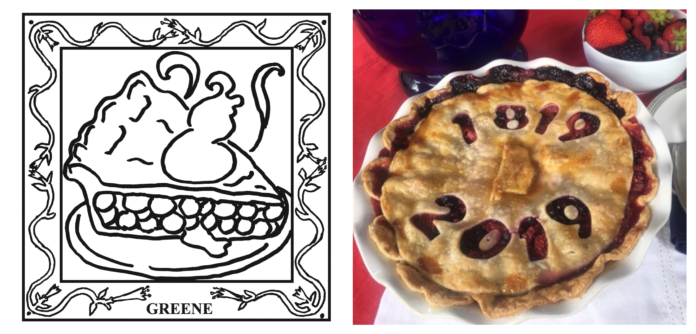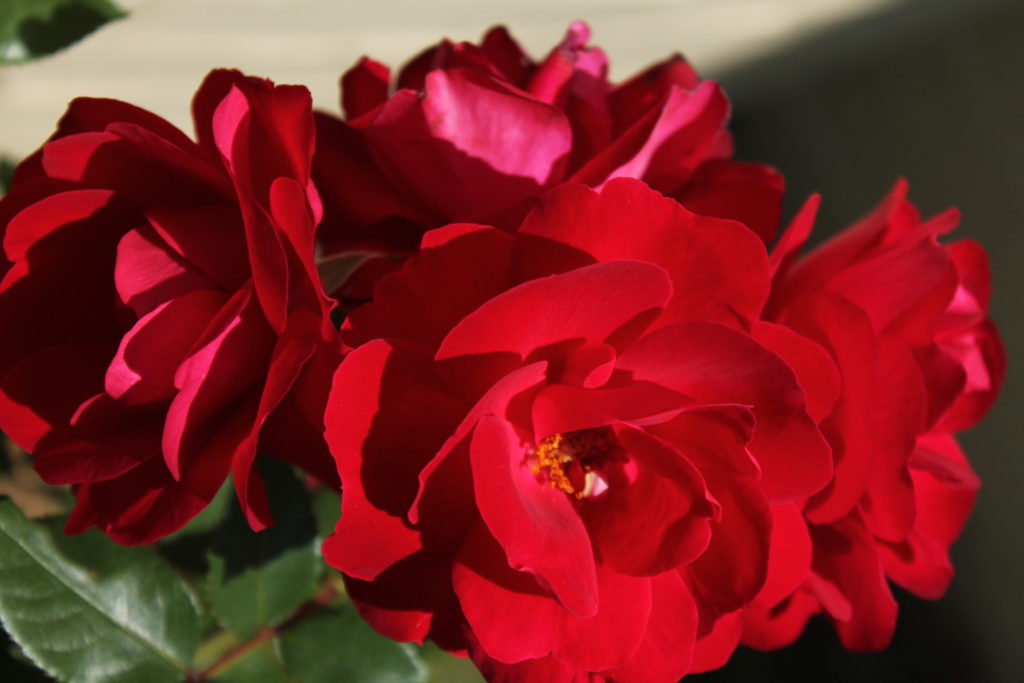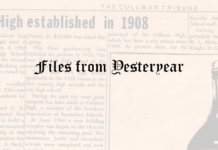
The Cullman Tribune is celebrating the Alabama Bicentennial (1819-2019) with statewide field reporting by Alabama Master Gardener/Botanical Artist Ben Johnson South. This year-long feature, “The 67-County Alabama Garden Party,” will spotlight different counties each week. Each county will get its own “quilt block,” along with a historical profile, and we’ll share a recipe specific to the area. At the end of the year, all 67 counties will be put in a book to commemorate the Bicentennial.
Greene County
Greene County pie is the answer. What was the question? We simply must have Greene County pie. These are stressful times we’re living through, America, and as playwright David Mamet said, “Stress cannot exist in the presence of pie.”
I’m a professional pie judge. It’s true. I’ve been judging pies at Alabama county fairs for a few years now. This will be chiseled on my tombstone, “Professional Pie Judge: It took the undertaker a week to wipe off the meringue and his smile.”
Greene County, Alabama may be the world epicenter of pie-making. What Mecca is to Muslims, Greene County is to pie-lovers. What Liverpool, England is to Beatlemania, Greene County, Alabama is to us passionate, fork-ready, pie people. (Someone cue Barbra Streisand) “People, pie people who love Greene County pie…are the luckiest people in the world.”
If you think you’ve had the best pie on the planet, but you haven’t had pie in this part of the world, you’re probably crazy as the nuts in some runner-up-to-Greene County pecan pie. There’s even a town in Greene County named, wait for this, Forkland. “Ladies and Gentleman, get your pie on. Welcome to Forkland, Alabama, USA.” If there’s not already an IHOP (International Hullabaloo of Pies) in Forkland, somebody please start a pie festival and let me come be the judge of it. “Here come da judge. Here come da pie judge.”
Greene County was established in December 1819. Cotton was the major agricultural crop, but thanks to the natural bounty of fruit trees, hard-working farm folks regularly rewarded themselves with apple, pear, persimmon and berry pies. And, the Native Alabamians in that area had been eating strawberries in various dishes for centuries. Specimens of their larger strawberry plants were shipped back to upgrade commercial nurseries in Europe.
Early English settlers in Greene County brought their pie-making traditions to Alabama, including baking fruit pies in long, narrow pans they called “coffins.” Historical culinary archives record fruit-pie baking in England as early as the 1500s. Also true and not some late-night television one-liner, Queen Elizabeth I, “The Virgin Queen,” is credited with inspiring the first cherry pie.
The Alabama Bicentennial Pie we are celebrating with Greene County has a trinity of berries that early-1800s settlers enjoyed: lowbush blueberries (Vaccinium angustifolium), wild blackberries which have been consumed by humans since the Iron Age, 2,500 years ago, and cultivated strawberries. Should you wish to add other gustatory goodness to salute the settlers and native Alabama plants, you could add locally-grown pecan meal or corn meal to your Bicentennial Pie crust.
“Bake the world a better place,” as they say here in Greene County. While we’re in pie country, let me share some pie-making tips I’ve learned from plowing through hundreds in my, uh, work. First, here’s a pie-EATING tip: When I’m presented with a whole pie to enjoy, I always ask for it to be cut into four pieces. I’m just not sure I could eat eight.
Life is what you bake it, and here’s some secrets for tasty pies:
- Cold dough creates flaky crust- You may have to keep chilling your pie dough repeatedly, but make sure it’s cold when it enters your oven. This is food chemistry. I don’t have the time to explain it…OK, or the science smarts, but pie bakers know this is the key to keeping pies from slumping.
- Fill your pie to the rim— Nobody likes a stingy little, wimpy pie; think Alabama abundance, ALAbundance. If it’s a fruit pie, peak it up a bit in the middle (An exception: unbaked pies with no upper crust should just be filled to the crimped rim).
- Do like Garth Brooks and have friends in low places- Bake your pie on the lowest rack to give the bottom crust and the wet filling the best chance to bake all the way through; nobody wants a soggy ass pie.
- Way down South we weigh down our pie crust- When you bake an empty pie crust, it’ll regularly warp and wave in weird ways. You can buy ceramic pie weights or you could do like settlers did 200 years ago and fill your pie plate with dried beans atop a baking crust; this will give your pie even edges and bottom. Gently lift out the dried beans and cool the crust before filling (Note: Many top pie bakers lay a sheet of parchment paper over a cold crust and then evenly distribute pie weights over this before baking).
- Cool your jets and cool your baked pie before you cut it- Let the delicious aroma waft through your house and yes, you’re drooling, but “STOP IT! DON’T CUT THAT PIE YET!” Sometimes this takes a few hours, but your patience will be rewarded with firm filling and smooth sides.
Pies make everybody happy. And, here are other ways PLANTS + PEOPLE in Greene County make for sweet happiness, including the recipe for our 1819 ALABAMA BICENTENNIAL BERRY PIE:
*GREENE COUNTY FARMERS MARKET—137 Furse Ave. (off Highway 43 South), Eutaw, AL 35462; Saturdays 8 a.m.-noon, April-September
*UNITED FARMERS MARKET—Intersection of County Road 41 and County Road 18, Forkland, AL 36740; Saturdays 10 a.m.-3 p.m., May-October; contact: Rugina Gulley, 334-289-4645
*GREENE COUNTY BLUEBERRY FARMERS—Tannur Ali, 205-310-6337, who also has collards, okra, squash, peppers, cabbage, rosemary, pears and apples; Curtis Gregory, 205-210-5272; David Bailey
*GREENE COUNTY CATFISH FARMING—This is a major industry and employer in Greene County; two prominent catfish farmers in this part of Alabama are Thed Spree and Jessie Green.
*BEST PLACE TO TAKE A LANDSCAPE PHOTOGRAPHER/PAINTER- Greene County photographer Mary Knott, who, with her talented sister, Johnnie Knott, own T&J Productions, suggested the historic architecture of the 1868 courthouse on the Eutaw square surrounded by cool, leafy trees.
*BEST FLOWER ARRANGEMENTS- Catherine’s Floral Boutique (Eutaw); also, Eutaw Accents
*HAYBALE FOLK ART OF JIM BIRD- (Forkland) This Greene County cattle rancher, now 90 years old, has been creating giant folk art out of haybales and junk on his farm since 1993. Like the art of pie-making, Mr. Bird’s sculptures, including a 32’ “Tin Man,” are about adding some smiles to life; Jim Bird budgets $5 to create each sculpture, though he splurged on $42, mostly for paint, on the “Tin Man.”
*MOMA’S GOT A SWITCH- A plant-centric song by Bobo Jenkins, a Greene County sharecropping farmer’s son who became a national, blues-singing sensation in Detroit; Mr. Jenkins, who died in 1984, also had hits with “Guitars on My Mind,” and “She Wanna Sell My Monkey.”
*ST. JOHN’S-IN-THE-PRAIRIE- (Forkland) This native tree, wooden Episcopal church started out Methodist on an Antebellum plantation in a nearby county and was south of Greensboro, Alabama. After the American Civil War, it was moved across the Black Warrior River to its present-day site in 1878 because the plantation owner had repurposed some of the wood of his home to build a saloon.
*PLANTING AN IDEA- Greene County could be the sweet home of an Alabama Pie School workshop which could teach traditional pie-making techniques as well as up-to-the-minute, 21st century pie-making innovations.
As we leave Greene County, let me leave you with this “pie joke” we judges learned from Bozo the Clown, though it may be 200 years old like Alabama: “Do you know how my hand is like a lemon ice box pie?” Answer: “It’s got meringue on it.”
Many thanks to Mary Knott of the Greene County office of Alabama Cooperative Extension System. And, thanks to Pie Baker Extraordinaire, Laurie Johnson, for creating THE 1819 ALABAMA BICENTENNIAL PIE.
Greene County – Alabama Bicentennial Berry Pie
This delicious “Happy Birthday, Alabama” pie is best made with any mixture of fresh berries when they are bountiful and in season, but it can be made with frozen berries as well.
Ingredients:
- 8 cups fresh berries (a combination of strawberries, blueberries, blackberries, raspberries)
- 1 1/2 cups granulated sugar, plus additional for sprinkling pie
- 6 tbsp. corn starch
- Juice from one lemon (about 2 tbsp.), plus zest from its peel
- 1 tbsp. balsamic vinegar – Use a berry- or dark cherry-infused vinegar if you can get it.
- 2 9-inch pie crusts for a double crust pie – can use the refrigerated type or make your own
- Softened butter for pan and 1 egg, beaten with a 1/2 tbsp. of water for egg wash on crust
Instructions:
- Preheat oven to 400 F and preheat a large cookie sheet in it.
- Wash berries and dry well so they don’t carry excess water into the pie filling. De-stem and cut strawberries into quarters. Measure 8 cups of mixed berries into a large mixing bowl.
- In a small bowl, blend the sugar and corn starch and sprinkle over the berries and gently stir with a large wooden spoon until well distributed.
- Combine the lemon juice, zest and balsamic vinegar and pour over the berries and stir again until well mixed. Set the mixture aside and stir a couple of times over the next 15 minutes.
- Rub the inside of a 9-inch pie pan with a little butter.
- Roll out the first pie crust and carefully place into the pan, crimping or ruffling the edge.
- Roll out the second pie crust and cut into a circle that just fits inside the first crust. Use cookie or crust cutters to cut out your message, such as “1819” and “2019” for this Bicentennial pie. Roll out remaining dough and cut into additional decorative shapes, such as the state of Alabama.
- Stir and then pour the berry filling into the crust and level out. Place the top crust (with the cut outs) over the filling, but save the additional decorative pieces for later. Lightly brush the egg wash over the top crust and ruffled edges and sprinkle with granulated sugar.
- Place pie on the heated cookie sheet and bake for about 15 minutes. Remove from oven and add the decorative crust cut out (the State of Alabama). Brush it with egg wash and sprinkle with sugar. Hint – on any double crust pie, the edge can brown too quickly and may burn before the pie is done. Use strips of aluminum foil or a pie crust shield to cover the outer rim as necessary, removing in the last few minutes of baking.
- Reduce oven temperature to 375 F and return the pie for another 30 – 35 minutes, or until the filling is just bubbling and crust is golden. Remove to a cooling rack and (mostly) cool before cutting. Enjoy your Bicentennial Pie with fresh berries and ice cream or whipped cream!
Also, check out Alabama Bicentennial: 200 ways to save Alabama for the next 200 years.
Copyright 2019 Humble Roots, LLC. All Rights Reserved.

Courtesy of Mary Knott and Johnnie Knott, T&J Productions, Greene County, AL























